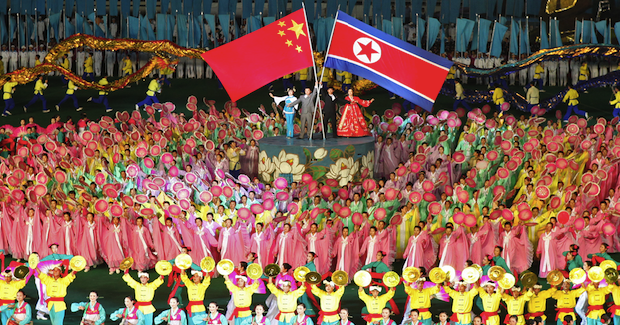A New Approach to Security in East Asia

The security situation in East Asia is precarious. There is the possibility that a war over regional supremacy may take place between China and Japan or between the US and China. This is further complicated by the fact that the Cold War has not ended on the Korean Peninsula and North Korea possesses nuclear weapons. What is needed to prevent an eruption of war is a more creative approach to security architecture in East Asia.
There are two types of security threats or challenges in East Asia. The nuclear-related threat from North Korea is an imminent military threat. The China-driven challenge is more complicated and full of uncertainties. On the one hand, China can bring prosperity and peace if its rise is indeed peaceful. On the other, it can also lead to conflict and war if China turns to expansionism or its rise is not managed well.
Approaching security threats
Traditionally, states respond differently to these two types of security challenges. For a military threat such as that posed by North Korea, states are more likely to use ‘hard balancing’. This involves military deterrence and constructing security alliances to neutralise the immediate threats. For example, the United States and South Korea argue that the reason for the deployment of the THAAD (Terminal High Altitude Area Defense) missile defence system is to deter North Korea’s potential threats.
For a rising China, states are more likely to choose a ‘hedging’ strategy for a bet both ways. The term hedging refers to the financial strategy of making investments in both directions. For example, many states in the Asia-Pacific, including Australia, choose to deepen their economic cooperation with China, but at the same time enhance military and security ties with the US in order to prepare for the worst.
The hard balancing strategy assumes the unchangeable nature of the security threat and the usefulness of military means. However, while hard balancing might be able to deter a short-term threa, it cannot neutralise or eliminate the threat in the long run. Since no one wants a second Korean War, mere military pressures and deterrence cannot force North Korea to change its behaviour.
For the hedging strategy, there is a passiveness problem. While it seems an ideal approach to have one’s cake and eat it too, there is no free lunch in the world and no country can hedge forever. Instead of passively accepting China’s rise, states need to consider how to actively shape the outcome of the rise of China as well as mitigating the potential competition between the US and China.
A different approach
Institutional balancing is another strategy for dealing with external challenges. Instead of using military means to conduct either external balancing (alliance formation) or internal balancing (arms build-ups), institutional balancing suggests that states can use the rules and norms of multilateral institutions to constrain other states’ behaviours and thereby reduce threats from others.
The ASEAN Regional Forum is good example of institutional balancing by Southeast Asian countries toward China in the post-Cold War era, especially in the 1990s. I would like to propose a new application of this strategy—dual-track institutional balancing— to cope with the security challenges posed by North Korea and China in the Asia-Pacific.
Isolation doesn’t work
On the first track of institutional balancing, states should consider how to engage North Korea instead of merely isolating or containing it. The Six-Party Talks (SPT) used to be a useful multilateral platform to engage North Korea. However, it eventually failed due to various reasons. One of the key problems is the different and even competing agendas brought by the six countries to the SPT. As we all know, the more parties in talks, the more veto players, and thereby the more difficulty in reaching an agreement. It will be more useful to consider a two-party or a four-party framework to engage North Korea.
The direct talks between the South and the North had some achievements during the ‘sunshine policy’ era in the early 2000s. Four-party talks, including the two Koreas, the US and China, might be another possibility. The key to any successful engagement is to change the perception of North Korea and treat it as a normal country. The major purpose of such talks is to socialise the North into the international community. This cannot be successful without China’s cooperation and coordination. For institutional balancing, the smaller the institutional engagement, the better the outcome.
Creating effective institutions
On the second track of institutional balancing, states should actively shape the rise of China through special institutions. The existing Trilateral Cooperation Secretariat (TCS), the Northeast Asia Peace and Cooperation Initiative (NAPCI) and ASEAN-driven multilateral institutions are all good platforms to engage China.
However, there are two problems. First, China has also proposed its own version of multilateral security architecture such as the Community of the Common Destiny (CCD) in the Asia-Pacific. We are therefore witnessing the emergence of contested multilateralism in the Asia-Pacific. Second, one danger of these competing ideas of multilateral institutions is the problem of ineffectiveness. There have been too many thought bubbles about institution building, illustrated by short-lived proposals such as the East Asian Community and Asia-Pacific Community.
One lesson that states need to learn in multilateralism is how to design specific institutions to cope with immediate challenges such as environmental disasters, transnational disease and financial instability. These targeted institutions are more likely to be successful than broad-themed institutions without substantial purposes. The success of the Asian Infrastructure Investment Bank is not a result of China’s soft power or attractiveness, but due to the specific niche of the bank—infrastructure development—that is badly needed in the region.
Australia will be better off to think about how to initiate a specific institution to engage both China and the US. Australia used to be active in initiating multilateral institutions, such as APEC in the early 1990s. It is now time for Australian policymakers to consider some specific institutions to involve both China and the US so that Australia can play a peace-broker role between the two giants to foster and further peaceful negotiations.
Kai He is an associate professor of international relations at the Griffith Asia Institute and the Centre for Governance and Public Policy at Griffith University. He is the author of China’s Crisis Behavior: Political Survival and Foreign Policy.
This article is published under a Creative Commons Licence and may be republished with attribution.





